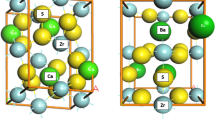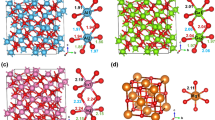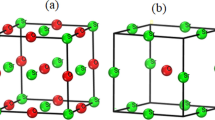Abstract
The phase diagram and thermodynamics data of the Bi-O system are reviewed and assessed. An optimized consistent thermodynamic description of the system at 1 bar total pressure is presented. The stable solid phases (solid Bi, α-Bi2O3, and δ-Bi2O3) are all treated as stoichiometric. The liquid phase is described by an ionic two-sublattice model, and the gas phase is treated as an ideal solution. Calculated phase diagrams and values for the thermodynamic properties of the bismuth oxides and the liquid are shown and compared with experimental data.
Similar content being viewed by others
Cited References
A. Ditte and R. Metzner, “Effect of Bismuth on Hydrochloric Acid,”Compt. Rend., 115, 1303–1305 (1892) in French.
W.G. Mixter, “The Heat of Formation of Trisodium Orthophosphate, Trisodium Orthoarsenate, the Oxides of Antimony, Bismuth Trioxide; and Fourth Paper on the Heat of Combination of Acidic Oxides with Sodium Oxide,”Am. J. Sci., 28, 103–111 (1909).
O. Hauser and W. Steger, “On the Specific Heat of Bismuth Oxide,” Z.Anorg. Chem., 80, 1–6 (1913) in German.
C.T. Anderson, “The Heat Capacities of Bismuth and Bismuth Trioxide at Low Temperatures,”J. Am. Chem. Soc 52, 2720–2723 (1930).
L.G. Sillén, “X-Ray Studies on Bismuth Trioxide, “Ark. Kemi Mineral. Geoi, 1–15(1937).
B. Aurivillius and L.G. Sillén, “Polymorphy of Bismuth Trioxide,”Nature, 755,305–306(1945).
C.B. Griffith and M.W. Mallett, “The Solubility of Carbon and Oxygen in Liquid Bismuth,”J. Am. Chem. Soc, 75, 1832–1834 (1953).
A.D. Mah, “Heats of Formation of Cerium Sesquioxide and Bismuth Sesquioxide by Combustion Calorimetry,”U.S. Bur. Mines RI, 5676 (1961).
G. Gattow and H. Schröder, “The Crystal Structure of the High-Temperature Modification of Bismuth(III)-Oxide (d-Bi2O3),”Z. Anorg. Allg. Chem., 318, 176–189 (1962) in German.
G. Gattow and D. Schütze, “On a Bismuth(III)-Oxide with Higher Oxygen Content (b-Modification),”Z Anorg. Allg. Chem., 328, 44–68 (1964) in German.
E.M. Levin and R.S. Roth, “Polymorphism of Bismuth Sesqui- oxide: I.Pure Bi2O3,”J. Res. Natl. Bur. Stand, 68A, 189–195(1964).
E.M. Levin and R.S. Roth, “Polymorphism of Bismuth Sesqui- oxide: II. Effect of Oxide Additions on the Polymorphism of Bi2O3,”J. Res. Natl. Bur. Stand., 68A, 197–206 (1964).
A.A. Zav’yalova, R.M. Imamov, and Z.G. Pinsker, “An Elec- tron-Diffraction Study of Thin Films in the Bi-O System,”Kristallo- grafiya, 9(6), 857–863 (1964) in Russian; TR:Sov. Phys. Crystallogr., 9(6), 724–728 (1964).
E.M. Levin and C.L. McDaniel, “Heats of Transformations in Bismuth Oxide by Differential Thermal Analysis,”J. Res. Natl. Bur. Stand., 69A, 237–243 (1965).
A.A. Zav’yalova, R.M. Imamov, and Z.G. Pinsker, “Crystal Structure of Hexagonal BiO,”Kristallografiya, 10(4), 480–484 (1965) in Russian; TR:Sov. Phys. Crystallogr., 70(4), 401–403 (1965).
D. Cubicciotti and H. Eding, “Enthalpy and Entropy Increments above 298 for BiBr3, Bi2O3, Tl2O3, and TI2,”J. Chem. Eng. Data, 12, 548–551(1967).
A.A. Zav’yalova and R.M. Imamov, “Crystal Structure of a New Tetragonal Phase in the Bi-O System,”Kristallografiya, 13(1), 49–52 (1968)in Russian;TR:Sov.Phys. Crystallogr., 13(1),37–39(1968).
C.N.R. Rao, G.V.S. Rao, and S. Ramdas, “Phase Transforma- tions and Electrical Properties of Bismuth Sesquioxide,”J. Phys. Chem., 73,672–675(1969).
D. Schiferl and C.S. Barrett, “The Crystal Structure of Arsenic at 4.2, 78 and 299 K,”J. Appl. Crystallogr., 2, 30–36(1969).
G. Malmros, “The Crystal Structure of a-Bi2O3,”Acta Chem. Scand, 24, 384–396(1970).
A. V.R. Rao and V.B. Tare, “Free Energy of Formation of Bi2O3,”Scr. Metall, 5, 807–811 (1971).
A.A. Zav’yalova and R.M. Imamov, “The Structure of β- Bi2O2.5 Thin Films,”Kristallografiya, 16(3), 516–519 (1971) in Rus- sian; TR:Sov.Phys. Crystallogr., 76(3), 437–439 (1971).
B. Aurivillius and G. Malmros,Kungliga Tekniska Högskolans Handlingar, 291,545 (1972); cited from (78Har) and [88BIo].
B. Codron, P. Perrot, and G. Tridot, “Determination of the Ther- modynamic Properties of the Liquid in the Pb-Bi-O System by EMF Measurements,”C.R. Acad. Sc. Sr. C,274,398–400 (1972) in French.
D. Chatterji and J. V. Smith, “Free Energy of Formation of Bi2O3, Sb2O3, and TeO2 from EMF Measurements,”J. Electrochem. Soc, 120,889–893(1973).
A. V.R. Rao and V.B. Tare, “Determination of the Melting Point and Heat of Fusion of Bi2O3 by the Solid Electrolyte Technique,”J. Electrochem. Soc. India, 22, 20–22 (1973).
J.W. Medernach, “On the Structure of Evaporated Bismuth Oxide Thin Films,”J. Solid State Chem., 15,352–359(1975).
A.V Korobeinikova, V.A. Kholmov, and L.A. Rezmitskii,Vest. Mosk. Univ. Khim., 17(3), 381 (1976) in Russian.
G.M. Mehrotra, M.G. Frohberg, and M.L. Kapoor, “Standard Free Energy of Formation of Bi2O3,” ZPhys. Chem. Neue Folge, 99, 304–307(1976).
B. Isecke, “Equilibria Study in the Bismuth-, Antimony-, and Lead-Oxygen Systems,” Dissertation, TU Berlin (1977) in German.
H.L. Lukas, E.T. Henig, and B. Zimmermann, “Optimization of Phase Diagrams by a Least Squares Method using Simultaneously Different Types of Data,”Calphad, 1, 225–236 (1977).
H.T. Cahen, M.J. Verkerk, and G.H.J. Broers, “Gibbs Free Energy of Formation of Bi2O3 from EMF Cells with δ-Bi2O3 Solid Electrolyte,”Electrochim. Acta, 23(8), 885–889 (1978).
H.A. Harwig, “On the Structure of Bismuth Sesquioxide: the α, β, γ, and δ-Phase,”Z. Anorg. Allg. Chem., 444, 154–166(1978).
H.A. Harwig and J.W. Weenk, “Phase Relations in Bismuth Sesquioxide,”Z. Anorg. Allg. Chem., 444, 167–177 (1978).
S.K. Hahn and DA. Stevenson, “Thermodynamic Investigation of Antimony+Oxygen and Bismuth+Oxygen using Solid-State Elec- trochemical Techniques,”J. Chem. Thermodynamics, 11, 621–631 (1979).
H.A. Harwig and A.G. Gerards, “The Polymorphism of Bismuth Sesquioxide,”Thermochim, Acta, 28, 121–131 (1979).
B. Isecke and J. Osterwald, “Equilibria Study in the Bismuth- Oxygen System,” Z.Phys. Chem. Neue Folge, 115, 17–24 (1979) in German.
K. Fitzner, “Diffusivity, Activity and Solubility of Oxygen in Liq- uid Bismuth,”Thermochim. Acta, 35, 277–286 (1980).
G. Gattow and W. Klippel, “Study of Bismuth(V)-Oxide,”Z. Anorg. Allg. Chem., 470, 25–34 (1980) in German.
L.N. Sidorov, I.I. Minayeva, E.Z. Zasorin, I.D. Sorokin, and A.Ya. Borshchevskiy, “Mass Spectrometric Investigation of Gas-Phase Equilibria over Bismuth Trioxide,”High Temp. Sci., 12, 175–196(1980).
V.E. Gorbunov, K.S. Gavrichev, O.A. Sarakhov, and V.B. Laz- arev, “Thermodynamic Functions of Bi2O3 in the Temperature Range 11–298 K,”Zh. Neorg. Khim., 26(2), 546–547 (1981) in Russian; TR:Russ. J. Inorganic Chem., 26(2), 297 (1981).
B. Heshmatpour and D.A. Stevenson, “An Electrochemical Study of the Solubility and Diffusivity of Oxygen in the Respective Liquid Metals Indium, Gallium, Antimony, and Bismuth,”J. Elec- troanal. Chem. Interfacial Electrochem., 130, 41–55(1981).
S. Otsuka, T. Sano, and Z. Kozuka, “Activities of Oxygen in Liq- uid Bi, Sn, and Ge from Electrochemical Measurements,”Metall. Trans.12(3), 427–433 (1981).
E.S. Anik, “On the Solubility of Oxygen in Binary Alloys under the Particular Consideration of Experimental Results in the Copper-Bismuth-Oxygen System at 1200 °C,” Dissertation, TU Berlin (1983) in German.
S. Itoh and T. Azakami, “Activity Measurements of Liquid Bi-Sb Alloys by the EMF Method using Solid Electrolytes,”J. Jpn. Inst. Met.,48, 293–301 (1984) in Japanese.
S.C. Marschman and D.C. Lynch, “Review of the Bi and Bi-O Vapor Systems,”Can. J. Chem. Eng., 62(6), 875–879 (1984).
S.C. Schaefer, “Electrochemical Determination of Thermody- namic Properties of Bismuth Sesquioxide and Stannic Oxide,”U.S. Bureau of Mines RI, 8906 (1984).
M. Hillert, B. Jansson, B. Sundman, and J. Agren, “A Two-Sublattice Model for Molten Solutions with Different Tendency for Ioniza- tion,”Metall. Trans. A, 16,261–266(1985).
J.-O. Andersson, A. Fernandez-Guillermet, P. Gustafson, M. Hillert, B. Jansson, B. Jönsson, Sundman, and J. Ågren, “A New Method of Describing Lattice Stabilities,”Calphad, 11, 93–98(1987).
A. Buker and Greaves, “Reduction and Reoxidation Be- haviour of α-Bi2MoO6,”J. Catal, 108,247–249(1987).
H. Kodama, A. Watanabe, and Y. Yajima, “Synthesis of a New Bismuth Oxide Fluoride with the β-Bi2O3 Structure Type,”J. Solid State Chem., 67,170–175 (1987).
S.K. Blower and C. Greaves, “The Structure of β-Bi2O3 from Powder Neutron Diffraction Data,”Acta Crystallogr. C, 44, 587–589 (1988).
B. Begemann, “On the Binary and Pseudobinary Oxides of Ar- senic, Antimony and Bismuth,” Dissertation, Universität Hannover (1989) in German.
B. Begemann and M. Jansen, “Bi4O7, the First Defined Binary Bismuth(III,V)-Oxide,”J. Less-Common Met., 156,123–135(1989) in German.
A.T Dinsdale, “SGTE Data for Pure Elements,”Calphad, 15, 317–425(1991).
K. Kameda and K. Yamaguchi, “Activity Measurements of Liquid Ag-Bi Alloys by an EMF Method using a Zirconia Electro- lyte,” J.-Jpn. Inst. Met., 55, 536–544 (1991) in Japanese.
K. Kameda, K. Yamaguchi, and T. Kon, “Activity of Liquid Tl- Bi Alloys Measured by an EMF Method using Zirconia Electrolyte,”J. Jpn. Inst. Met., 56, 900–906 (1992) in Japanese.
H.L. Lukas and S.G. Fries, “Demonstration of the use of BINGSS with the Mg-Zn System as Example,”J. Phase Equilibria, 13(5), 532–541 (1992).
B. Hallstedt, D. Risold, and L. J. Gauckler, “Thermodynamic As- sessment of the Copper-Oxygen System,”J. Phase Equilibria, 15(5), 483–499(1994).
The SGTE substance database, version 1994, SGTE (Scientific Group Thermodata Europe), Grenoble, France, 1994.
N. Kinomura and N. Kumada, “Preparation of Bismuth Oxides with Mixed Valence from Hydrated Sodium Bismuth Oxide,”Mater. Res. Bull., 30(2), 129–134(1995).
Author information
Authors and Affiliations
Rights and permissions
About this article
Cite this article
Risold, D., Hallstedt, B., Gauckler, L.J. et al. The bismuth-oxygen system. JPE 16, 223–234 (1995). https://doi.org/10.1007/BF02667306
Received:
Revised:
Published:
Issue Date:
DOI: https://doi.org/10.1007/BF02667306




